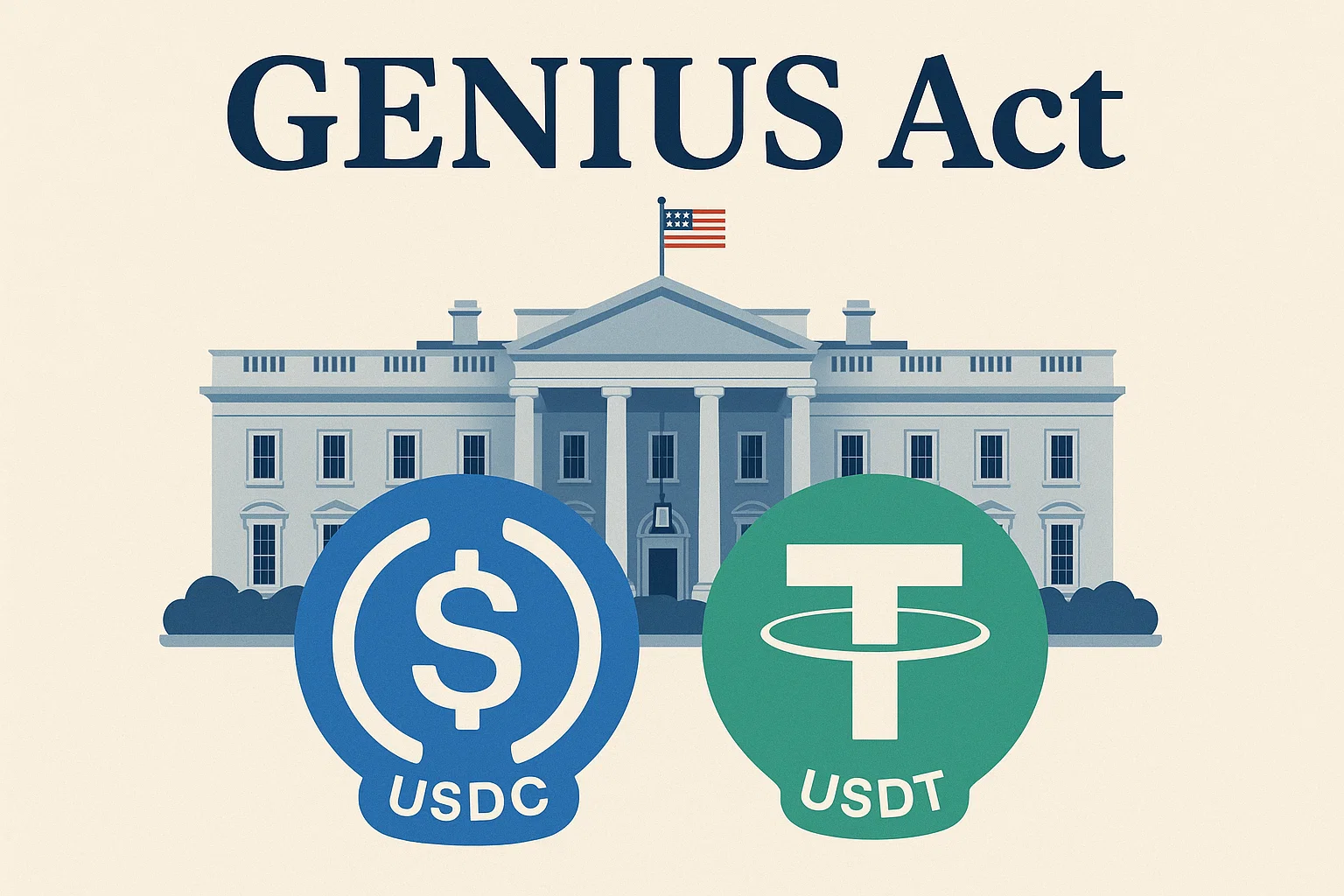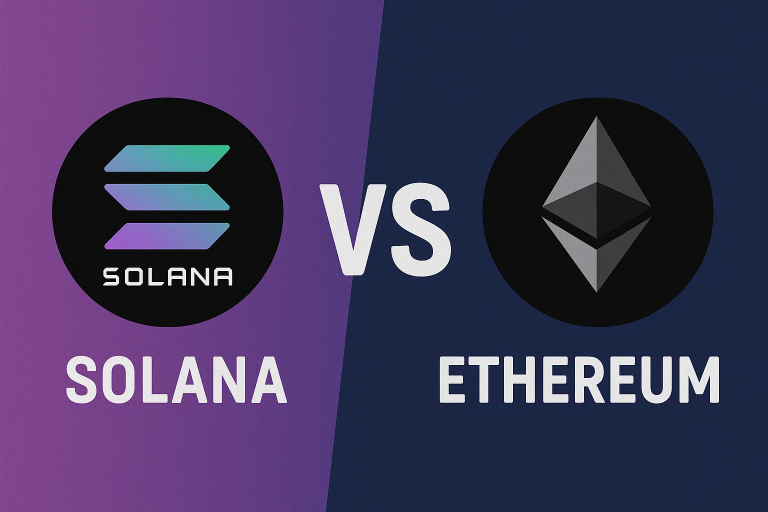Exploring the future of digital economy
The GENIUS Act: America’s First Stablecoin Law

What is the GENIUS Act?
The Generational Innovation, Uniform Security, and Trust in Financial Technology (GENIUS) Act is the first major federal law in the United States aimed at regulating stablecoins — digital assets pegged to fiat currencies like the U.S. dollar.
This landmark bill establishes a comprehensive regulatory framework for companies issuing stablecoins, including:
- Full-reserve backing: Each stablecoin must be fully backed by high-quality liquid assets.
- Monthly reporting: Issuers must publish monthly transparency reports on their reserves.
- Licensing requirements: Companies must obtain either federal or state-level licenses to operate.
- Anti-Money Laundering (AML) compliance: Issuers must adhere to the same AML standards as traditional banks.
- Bankruptcy protections: In case of insolvency, stablecoin holders have priority claim over the issuer’s assets.
Impact on Users and Businesses
For Consumers
Stablecoins will become as safe and transparent as bank deposits, with full reserve backing and public reporting. This increased trust may lead to broader adoption:
- Major retailers, banks, and payment processors are expected to start accepting them.
- Mobile apps will offer seamless conversion between dollars and stablecoins.
- Users can expect clear redemption mechanisms and enhanced consumer protection.
For Business and Finance
- Companies can now legally adopt stablecoins for internal systems, supply chain finance, and even issue their own branded tokens (e.g., Amazon Coin, Walmart Coin).
- Banks and investment funds gain legal clarity to invest in the sector.
- Institutional investors — such as pension funds, insurance companies, and large banks — will be able to participate in crypto markets.
- DeFi protocols can integrate regulated stablecoins, while traditional exchanges can list them alongside stocks.
Why Is the U.S. Government Supporting It?
A New Source of Automatic Funding for U.S. Debt
At the heart of the GENIUS Act lies a powerful economic mechanism:
- When users buy stablecoins with dollars, those dollars are typically invested in U.S. Treasury bonds.
- With yields currently around 4–5% annually, this creates a sustainable revenue stream for stablecoin issuers — and indirectly, for the U.S. government.
Example: Tether (USDT)
- Tether holds approximately $120 billion in USDT supply.
- It has invested nearly the same amount in U.S. Treasuries.
- At a 5% yield, Tether earns about $6 billion per year solely from interest income.
This dynamic means that every new dollar invested in compliant stablecoins becomes a guaranteed buyer of U.S. debt — effectively automating demand for Treasury securities.
Ties to Trump
- Trump’s sons launched World Liberty Financial , which introduced USD1, a stablecoin now among the top 10 by market cap.
- Like Tether, it invests in U.S. Treasuries — further tying the administration’s financial interests to the growth of the stablecoin ecosystem.
Projected Growth
According to U.S. Treasury Secretary Scott Bessent, the stablecoin market could reach $3.7 trillion by 2030 , meaning an additional $3.7 trillion in demand for U.S. Treasuries — a powerful tool for financing the national debt without raising taxes or increasing borrowing costs.
Geopolitical Implications
Stablecoins are already popular in countries suffering from high inflation (e.g., Argentina, Turkey, Lebanon), where people use USDT and USDC to protect their savings. The GENIUS Act enhances the reliability and appeal of these digital dollars, reinforcing the U.S. dollar’s global dominance.
Challenges to Dollar Hegemony
Efforts by BRICS nations and others to create alternatives to the dollar are underway:
- Circle has received approval in the UAE to launch a dirham-backed stablecoin.
- Russia is exploring replacing USDT with a digital ruble.
- China continues to push its digital yuan.
However, dollar-based stablecoins still hold a massive advantage in liquidity, trust, and global usage.
Market Fragmentation
Tether’s current USDT does not meet the GENIUS Act’s requirements. As a result, the company is considering launching a separate U.S.-compliant token, potentially splitting the market into:
- Regulated stablecoins for the U.S. and Europe
- Unregulated or lightly regulated stablecoins for the rest of the world
Legislative Process and Current Status
Senator Bill Hagerty (R-TN) introduced the bill in May 2025. Historically, bipartisan gridlock had blocked previous attempts at crypto regulation. However, this time many Democrats joined Republicans in supporting the bill, arguing that “a flawed law is better than no law.”
- June 11, 2025 : Senate approves the bill — 68 in favor, 30 against
- June 18, 2025 : Final Senate vote — same outcome
- Next step : House of Representatives vote
- President Trump supports the bill and intends to sign it before August 2025
Comparison with EU Regulation (MiCA)
While the EU approach emphasizes consumer protection and regulatory rigor, the U.S. model offers greater flexibility and innovation-friendly licensing. Both systems require full asset backing and regular audits, ensuring comparable levels of stability and trust.
Reactions from Key Figures and Influencers
Donald Trump
“The Senate just passed an incredible bill that will make America the UNDISPUTED leader in digital assets — nobody will do it better, it’s pure GENIUS! Digital assets are the future, and our nation will own it. We’re talking MASSIVE investments and big innovations. House, let’s hope you act LIGHTNING FAST and pass the ‘clean’ GENIUS law. Get it to my desk IMMEDIATELY — NO DELAYS, NO AMENDMENTS. This is American genius at its best, and we’ll show the world how to WIN with digital assets like never before!”
Scott Bessent (Treasury Secretary)
“Recent projections suggest stablecoins could grow to a $3.7 trillion market by the end of the decade. That scenario becomes more likely with the passage of the GENIUS Act. A thriving stablecoin ecosystem will drive private-sector demand for U.S. Treasuries used to back stablecoins. This new demand could lower the government’s borrowing costs and help curb the national debt. It could also bring millions of new users worldwide into a dollar-based digital economy. It’s a win for everyone involved: the private sector, the Treasury, and consumers. That’s what smart, pro-innovation legislation looks like.”
Elizabeth Warren (Senator)
“Republican leader John Thune is blocking critical amendments that would fix the GENIUS bill — including banning Donald Trump from profiting off shady crypto deals. Democrats have the power to demand fixes. We must use it.”
Steve Hou (Bloomberg Analyst)
“The GENIUS Act isn’t about automatically granting citizenship to foreign geniuses. It’s about legalizing the ‘on-ramp’ to crypto. The word ‘Genius’ in the title is probably ironic commentary on the legislative process itself.”
Michael Bennet (Senator)
“Republicans are rushing to pass the so-called GENIUS Act — and rejected my amendment that would ban the president and vice president from issuing their own stablecoins.”
Satoshi Flipper (Crypto Influencer)
“Wow, some people actually think the GENIUS Act gives companies the ability to issue their own digital currencies — just like central banks.”
Conclusion
The GENIUS Act represents a strategic move by the United States to maintain its financial leadership in the age of digital assets. By creating a robust, transparent, and innovation-friendly regulatory environment for stablecoins, the U.S. aims to:
- Reinforce the global dominance of the U.S. dollar
- Automate funding for U.S. government debt
- Enable widespread adoption of digital money
- Attract institutional capital and global users
In essence, the law is a win-win: governments gain a new financial tool, businesses gain legitimacy and opportunity, and users gain security and utility.
As the bill moves toward final passage, all eyes are on Washington — and the world watches closely to see how this bold experiment in digital finance unfolds.


